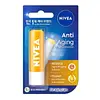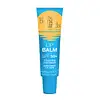What's inside
What's inside
 Key Ingredients
Key Ingredients

 Benefits
Benefits

 Concerns
Concerns

 Ingredients Side-by-side
Ingredients Side-by-side

Octyldodecanol
EmollientRicinus Communis Seed Oil
MaskingHydrogenated Rapeseed Oil
EmollientBeeswax
Emulsion StabilisingHomosalate
Skin ConditioningOctocrylene
UV AbsorberCetyl Palmitate
EmollientButyl Methoxydibenzoylmethane
UV AbsorberEthylhexyl Salicylate
UV AbsorberCetyl Ricinoleate
EmollientBis-Diglyceryl Polyacyladipate-2
EmollientCetearyl Alcohol
EmollientButyrospermum Parkii Butter
Skin ConditioningPersea Gratissima Oil
Skin ConditioningSimmondsia Chinensis Seed Oil
EmollientTocopheryl Acetate
AntioxidantBHT
AntioxidantParfum
MaskingCI 77891
Cosmetic ColorantCI 77492
Cosmetic ColorantOctyldodecanol, Ricinus Communis Seed Oil, Hydrogenated Rapeseed Oil, Beeswax, Homosalate, Octocrylene, Cetyl Palmitate, Butyl Methoxydibenzoylmethane, Ethylhexyl Salicylate, Cetyl Ricinoleate, Bis-Diglyceryl Polyacyladipate-2, Cetearyl Alcohol, Butyrospermum Parkii Butter, Persea Gratissima Oil, Simmondsia Chinensis Seed Oil, Tocopheryl Acetate, BHT, Parfum, CI 77891, CI 77492
Ricinus Communis Seed Oil
MaskingOctyldodecanol
EmollientSynthetic Beeswax
Emulsion StabilisingMicrocrystalline Wax
Emulsion StabilisingHydrogenated Polydecene
EmollientCocoglycerides
EmollientCetyl Palmitate
EmollientButylene Glycol
HumectantButyrospermum Parkii Butter
Skin ConditioningSimmondsia Chinensis Seed Oil
EmollientButyl Methoxydibenzoylmethane
UV AbsorberOctocrylene
UV AbsorberEthylhexyl Triazone
UV AbsorberAroma
Triacontanyl Pvp
HumectantPEG-30 Dipolyhydroxystearate
EmulsifyingBis-Ethylhexyloxyphenol Methoxyphenyl Triazine
Skin ConditioningBHA
AntioxidantSaccharin
MaskingTocopheryl Acetate
AntioxidantAnise Alcohol
PerfumingRicinus Communis Seed Oil, Octyldodecanol, Synthetic Beeswax, Microcrystalline Wax, Hydrogenated Polydecene, Cocoglycerides, Cetyl Palmitate, Butylene Glycol, Butyrospermum Parkii Butter, Simmondsia Chinensis Seed Oil, Butyl Methoxydibenzoylmethane, Octocrylene, Ethylhexyl Triazone, Aroma, Triacontanyl Pvp, PEG-30 Dipolyhydroxystearate, Bis-Ethylhexyloxyphenol Methoxyphenyl Triazine, BHA, Saccharin, Tocopheryl Acetate, Anise Alcohol
 Reviews
Reviews

Ingredients Explained
These ingredients are found in both products.
Ingredients higher up in an ingredient list are typically present in a larger amount.
Also known as Avobenzone, this ingredient is a chemical sunscreen filter that provides protection in the UV-A range.
Avobenzone is globally approved and is the most commonly used UV-A filter in the world.
Studies have found that avobenzone becomes ineffective when exposed to UV light (it is not photostable; meaning that it breaks down in sunlight). Because of this, formulations that include avobenzone will usually contain stabilizers such as octocrylene.
However, some modern formulations (looking at you, EU!) are able to stabilize avobenzone by coating the molecules.
Avobenzone does not protect against the UV-B range, so it's important to check that the sunscreen you're using contains other UV filters that do!
The highest concentration of avobenzone permitted is 3% in the US, and 5% in the EU.
Learn more about Butyl MethoxydibenzoylmethaneThis ingredient is also known as shea butter. It is an effective skin hydrator and emollient.
Emollients help soothe and soften your skin. It does this by creating a protective film on your skin. This barrier helps trap moisture and keeps your skin hydrated. Emollients may be effective at treating dry or itchy skin.
Shea butter is rich in antioxidants. Antioxidants help fight free-radicals, or molecules that may harm the body. It is also full of fatty acids including stearic acid and linoleic acid. These acids help replenish the skin and keep skin moisturized.
While Shea Butter has an SPF rating of about 3-4, it is not a sunscreen replacement.
Shea butter may not be fungal acne safe. We recommend speaking with a professional if you have any concerns.
Learn more about Butyrospermum Parkii ButterCetyl Palmitate is a wax-like substance.
It comes from palmitic acid and palmityl alcohol. Cetyl Palmitate may not be safe for Malassezia folliculitis, or fungal-acne.
This ingredient is naturally found in the guava fruit and stony corals.
Learn more about Cetyl PalmitateOctocrylene protects skin from sun damage. It absorbs UV-B with peak absorption of 304 nm. It is a common sunscreen ingredient and often paired with avobenzone, a UVA filter. This is because octocrylene stabilizes other sunscreen ingredients by protecting them from degradation when exposed to sunlight. Octocrylene is a photostable ingredient and loses about 10% of SPF in 95 minutes.
Octocrylene also acts as an emollient, meaning it helps skin retain moisture and softens skin. It is oil-soluble and hydrophobic, enhancing water-resistant properties in a product.
Those who are using ketoprofen, a topical anti-inflammatory drug, may experience an allergic reaction when using octocrylene. It is best to speak with a healthcare professional about using sunscreens with octocrylene.
The EU allows a maximum of these concentrations:
Learn more about OctocryleneOctyldodecanol is a fatty alcohol. It is primarily used to enhance the texture of products.
As an emulsifier, Octyldodecanol helps prevent the oils and waters from separating. It also prevents ingredients from creating foam when shaken.
Octyldodecanol is created by reducing fatty acid to an alcohol.
Due to its high molecular weight, it does not get absorbed into the skin.
Learn more about OctyldodecanolRicinus Communis Seed Oil is the INCI name for castor oil.
Castor Oil helps moisturize the skin. It is rich in a fatty acid called ricinoleic acid. This fatty acid helps prevent moisture loss on the skin. This helps keep your skin soft and hydrated. Ricinoleic acid also has anti-inflammatory and pain reducing properties.
Besides hydrating the skin, castor oil is also used to hydrate hair. By keeping the hair shaft moisturized, breakage is decreased. More studies are needed to show castor oil's effective on stimulating hair growth.
Castor oil is created by cold-pressing castor seeds and then purifying the oil with heat. It was used in Ancient Egypt as fuel in lamps and to help treat eye irritation.
The term 'fragrance' is not regulated in many countries. In many cases, it is up to the brand to define this term. For instance, many brands choose to label themselves as "fragrance-free" because they are not using synthetic fragrances. However, their products may still contain ingredients such as essential oils that are considered a fragrance.
Learn more about Ricinus Communis Seed OilThis oil comes from the seeds of the desert shrub called Jojoba. It is more commonly known as jojoba oil, a non-comedogenic oil.
Jojoba oil does not contain fragrance and has many fatty-acids, making it a great soothing ingredient.
It also contains Vitamin E, a great moisturizing ingredient. Vitamin E is also an antioxidant and protects your skin against oxidative damage.
This ingredient humectant properties, meaning it helps draw moisture from the air. This helps keep your skin hydrated.
While jojoba has antibacterial properties, it is only able to kill some strains of bacteria.
Studies also show it helps in wound healing. In fact, Indigenous cultures have used jojoba as a moisturizer and to help treat burns for centuries.
Fun fact: Jojoba oil similar to natural human skin sebum, so it has a great effect on dry skin. It is also promising with helping to regulate sebum production.
Due to its fatty acid content, Jojoba oil may not be fungal acne safe. We recommend speaking with a professional if you have any concerns.
Learn more about Simmondsia Chinensis Seed OilTocopheryl Acetate is AKA Vitamin E. It is an antioxidant and protects your skin from free radicals. Free radicals damage the skin by breaking down collagen.
One study found using Tocopheryl Acetate with Vitamin C decreased the number of sunburned cells.
Tocopheryl Acetate is commonly found in both skincare and dietary supplements.
Learn more about Tocopheryl Acetate